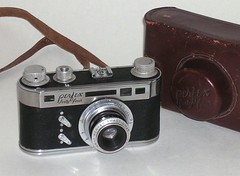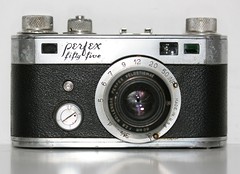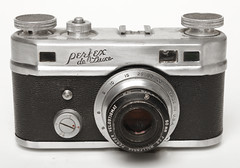Perfex

|
| Perfex Speed Candid image by Simon Spaans (Image rights) |
Perfex was the brand name used by Candid Camera Corporation of Chicago, Illinois, founded by Carl and Joseph Price together with Benjamine Edelman. The company focussed on 35mm rangefinder cameras, but also produced a double 8mm movie camera. Perfex cameras were in production from 1938 through 1950.
Perfex Cameras
The first Perfex camera was the 1938 Speed Candid. This camera takes 135 film, and has a built-in extinction light meter, an uncoupled rangefinder, and a cloth focal plane shutter with speeds up to 1/500 of a second. It has a Bakelite body, styled like a contemporary Argus. It was available with either an f3.5 or f2.8 50mm Graf Perfex Anastigmat lens.
The Forty-Four quickly superseded the crude Speed Candid in 1939. This model has a more cleanly styled body, a coupled rangefinder, a hot shoe, and shutter speeds from 1 second to 1/1250 second. This model was replaced by the Fifty-Five in 1940.
The Perfex Forty-Four features some very high specs for its time, including a built-in light meter (albeit an extinction meter), exposure calculator, coupled rangefinder, and built-in flash synch. It is perhaps the only pre-war camera that provides all of these features built-in. With this camera the photographer ostensibly does not need to carry any other equipment to measure light values or focus distances. Its rangefinder focus base is very wide, nearly the same width as the famously wide focus base of the contemporary Contax II, which allows more accurate focusing. Its top shutter speed of 1/1250 second matches the fastest shutter speed of the Contax II as well. This camera was heavily marketed as a true American-made competitor to the German Contax and Leica cameras at the time, which cost four to fives times the price of the Perfex. Although the camera was feature-laden, it proved unreliable and did not match the quality of the German cameras.
Early models of the Forty-Four feature two levers prominently on the face of the camera: the upper lever is the film rewind release lever, and the lower lever is used to engage slow shutter speeds on the camera. Late in the Forty-Four production run these levers were replaced by a button for the film rewind release, and a dial for the slow shutter speeds. This button and dial arrangement continued into the Fifty-Five series.
The Thirty-Three, introduced in 1940, is essentially the same camera as the Forty-Four but with blacked out trim, and without the slow shutter speeds. Some Thirty-Three cameras use a riveted nameplate on the top plate of the camera, rather than the name being engraved into the face plate.
The Fifty-Five is essentially an updated and further refined version of the Forty-Four. It also was introduced in 1940 along with the Thirty-Three. This model survived WWII and was discontinued in 1947. Early models include the extinction meter that was used on the Forty-Four and Thirty-Three models, while later models delete this feature. Interestingly, both models use the same instruction manual; the instruction manual supplied with the later non-extinction meter models uses very obviously edited photos in which the extinction meter that appeared on the camera that was photographed for the original manual is simply covered up.
Shutter speeds range from 1 second to 1/1250 second, with slow speeds (1, 1/2, 1/5, 1/10 second, and B) being accessed by a separate dial on the face of the camera. The slow speed dial must be wound in addition to the normal shutter winding. Curiously, although the camera is equipped with a Bulb shutter setting, the camera lacks any means of attaching a cable release for the shutter.
The Fifty-Five was offered with one of four different standard lenses, listed in order of original cost from lowest to highest:
- 2-inch f/3.5 Scienar
- 2-inch f/3.5 Wollensak Perfex Velostigmat
- 2-inch f/2.8 Scienar
- 2-inch f/2.8 Wollensak Perfex Velostigmat
Also offered were a 6-inch f/4.5 and a 4-inch f/4.5 telephoto. The 6-inch lens was fitted with a special "micromatic focusing mount". Other accessories that were available for this camera were a Perfex Flash Gun, and a range of lens extension tubes from 11/32-inch up to 6-inch. A leather "eveready" case was also offered.
During the war, an unusual model was introduced, named the Twenty-Two. This model was built between 1942 and 1945. It appears to be made from surplus parts, as materials for new cameras presumably dried up during the war. The primary features of the camera appear to be identical to the Fifty-Five, with an extinction meter and the Fifty-Five's slow speed dial and rewind button. However, the top plate of the camera is blacked out like a Thirty-Three, with a name plate riveted onto the top plate instead of the name being engraved into the face of the top plate (similar to some Thirty-Three cameras with riveted name plates). It is very likely that this camera was assembled using old Thirty-Three top plates (in black), with the Twenty-Two name plate instead of the Thirty-Three, the rest of the camera being comprised of Fifty-Five parts.
The de Luxe is much the same as the earlier models, but has a stamped metal body instead of a cast one.
The One-O-One and One-O-Two were introduced in 1948 and have an f4.5 and f3.5 lens respectively. They differ from the earlier Perfex models by having fixed lenses, and leaf shutters. They also lack the extinction meters that were standard on the pre-war models.
|
| ||||
|
|
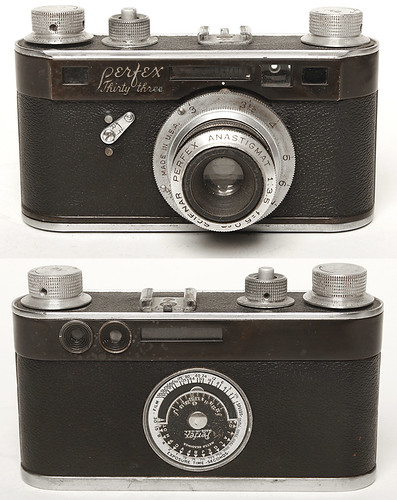
|
| Perfex Thirty-Three image by Rick Soloway (Image rights) |
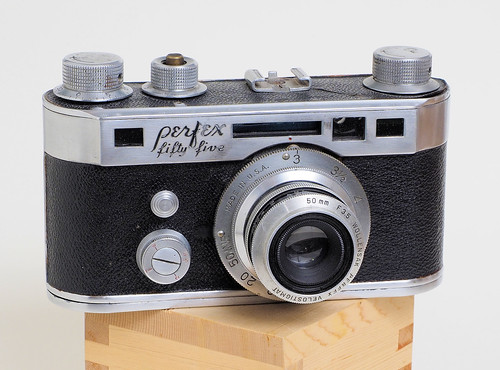
|
| Perfex Fifty-Five with extinction meter image by Tarn McDaddo (Image rights) |

|
| Perfex Fifty-Five - rear image by Tarn McDaddo (Image rights) |
Cee-ay 35
The Cee-Ay 35 was introduced in 1949; but few were made before Perfex sold the design to Ciro who sold a slightly-modified version as the Ciro 35. This model continued after Ciro was absorbed by Graflex.
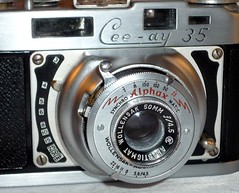
|
| Cee-Ay 35 image by Manuel Barriga (Image rights) |
Links
- Speed Candid Review at Scott's Photgraphica
- Speed Candid advertisement January, 1939 Popular Photography magazine
- Details of several Perfex models at Cameraquest
- Perfex Fifty-Five review (archived)
- Perfex Delux, Perfex one-O-one, Perfex Fifty-Five on www.collection-appareils.fr by Sylvain Halgand (in French)
| Companies of Chicago (Illinois) |
| Adams & Westlake | Central Camera Co. | American Advertising and Research Co. | Bernard | Burke & James | Busch | Calumet | Candid | Chicago Aerial | Chicago Camera Co. | Chicago Ferrotype Company | Deardorff | De Vry | Drucker | Galter | Geiss | Herold | Imperial | Kemper | Lennor Engineering Co. | Metropolitan Industries | Monarch | Montgomery Ward | Pho-Tak | QRS Company | Rolls | Sans & Streiffe | Sears | Seymour | Spartus | The Camera Man | United States Camera Co. | Western Camera Manufacturing Co. | Yale | Zar | Zenith |
| Chicago in depth: The Chicago Cluster, a bakelite trust? |
